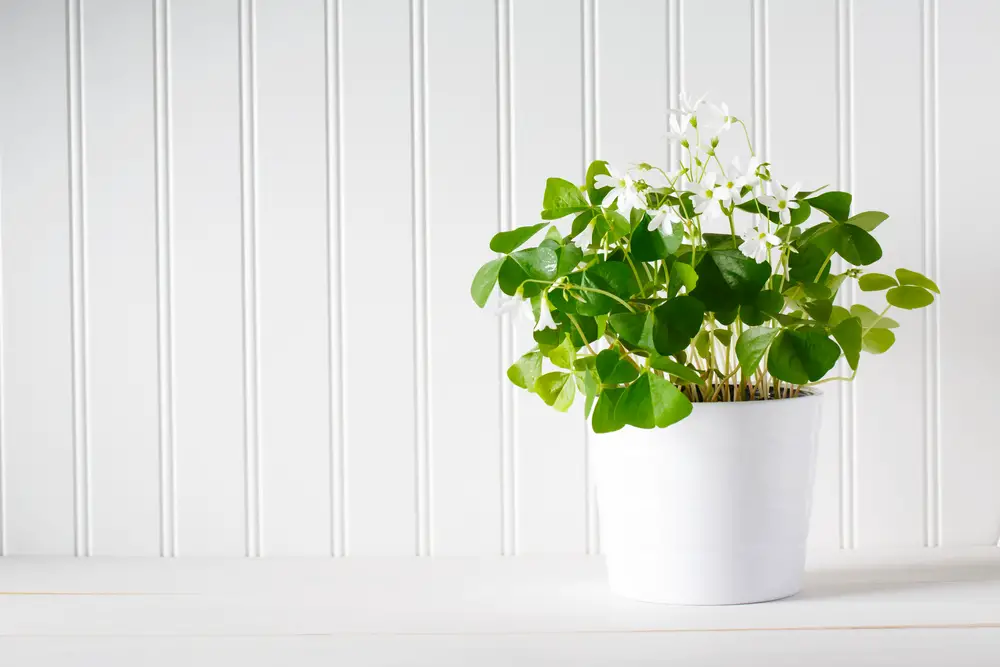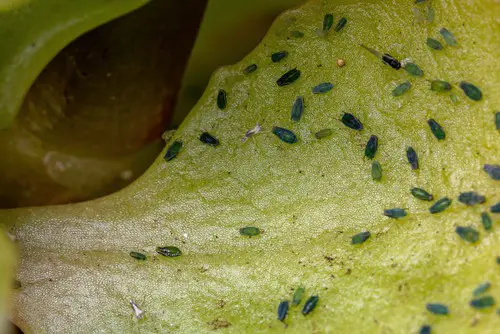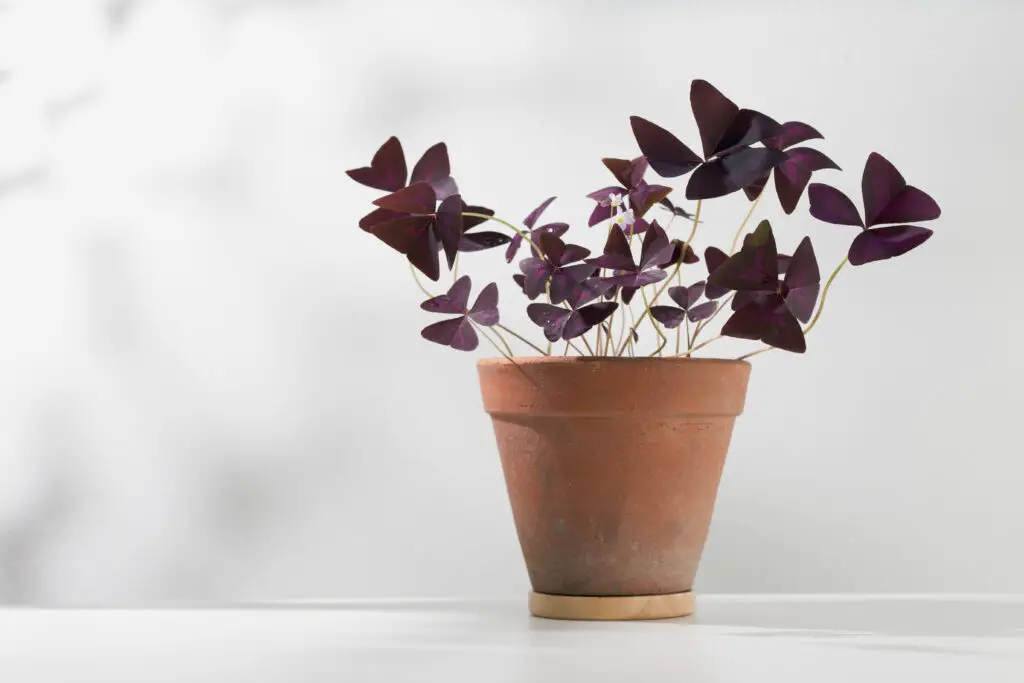Shamrock plants are a popular houseplant due to their attractive foliage and easy care requirements. However, many plant owners may encounter the problem of their shamrock plant dying.
While this can be alarming, it is important to understand that shamrock plants have a natural dormancy period where they lose their leaves and go dormant for a few weeks to a few months. This is part of their normal growing cycle and should not be a cause for concern.
If a shamrock plant appears to be dying outside of its dormancy period, it may be due to improper care or a pest or disease infestation. Proper care for shamrock plants includes providing them with bright, indirect light, regular watering, and well-draining soil.
Common causes for Shamrock Plant Dying include overwatering, underwatering, lack of light, and pest infestations. It is important to diagnose the cause of the problem before attempting to revive the plant.
Key Takeaways on Shamrock Plant Dying
- Shamrock plants have a natural dormancy period where they lose their leaves and go dormant for a few weeks to a few months.
- Proper care for shamrock plants includes providing them with bright, indirect light, regular watering, and well-draining soil.
- Common causes of a dying shamrock plant include overwatering, underwatering, lack of light, and pest infestations.
See other reasons why your favorite houseplants might be dying & how to revive them:
Understanding Shamrock Plants

Shamrock plants, also known as Oxalis, are popular indoor plants that are easy to care for and add a pop of green, red, or purple foliage to any room. These plants are known for their unique triangular leaves that fold up at night and open during the day.
Shamrock plants come in a variety of colors, with the green variety being the most common.
One of the most interesting things about shamrock plants is their association with good luck. According to Irish folklore, the shamrock plant is said to bring good luck to those who possess it. This belief is so strong that many people give shamrock plants as gifts to their loved ones on St. Patrick’s Day.
Shamrock plants are typically grown from bulbs and can produce small, delicate flowers in shades of white, pink, and purple. While the flowers are beautiful, the foliage is the main attraction of these plants. The leaves can be green, red, or purple and come in a variety of shapes and sizes.
Despite their reputation for being easy to care for, shamrock plants can sometimes experience problems. One common issue is leaf drop, which can be caused by overwatering or underwatering. It’s important to keep the soil moist but not waterlogged, and to avoid letting the soil dry out completely.
Another issue that shamrock plants can experience is leaf curl, which is often caused by low humidity or exposure to direct sunlight. To prevent this, it’s important to keep the plant in a location with bright, indirect light and to mist the leaves regularly.
Proper Care for Shamrock Plants
Shamrock plants are relatively easy to care for, but they do require some attention to thrive. Proper care will help prevent the plant from dying prematurely. Here are some tips for caring for your shamrock plant:
1. Watering
Shamrock plants prefer well-drained soil that is kept consistently moist. Water the plant when the top inch of soil feels dry to the touch, but be careful not to overwater.
Overwatering can cause the roots to rot, which can lead to the death of the plant. It is also important to ensure that the pot has proper drainage to prevent water from accumulating in the soil.
2. Light

Shamrock plants prefer bright, indirect light. Direct sunlight can scorch the leaves, so it is best to place the plant in a location where it will receive bright light for several hours a day but not direct sunlight.
3. Soil
Shamrock plants prefer well-drained soil that is rich in nutrients. It is best to use a high-quality potting mix that is specifically formulated for houseplants. The soil should be moist but not waterlogged.
4. Fertilizer
Shamrock plants benefit from regular fertilization. Use a balanced, water-soluble fertilizer every two to three weeks during the growing season (spring and summer). Do not fertilize the plant during its dormancy period (fall and winter).
5. Repotting
Shamrock plants should be repotted every two to three years. When repotting, choose a pot that is one size larger than the current pot. Use fresh potting soil and ensure that the pot has proper drainage.
6. Dormancy
Shamrock plants go through a period of dormancy in the fall and winter. During this time, the plant will stop growing and may lose some of its leaves. Reduce watering and stop fertilizing during this period. The plant will begin to grow again in the spring.
Common Causes of a Dying Shamrock Plant

Shamrock plants are known for their beautiful and unique foliage. However, when a shamrock plant starts to die, it can be a cause for concern. There are several common causes of a dying shamrock plant that are important to be aware of in order to keep your plant healthy and thriving.
One of the most common causes of a dying shamrock plant is overwatering. Shamrocks prefer moist soil but not waterlogged soil. When the soil is too wet, the roots can start to rot, which can lead to stunted growth, yellow leaves, and even brown, wilted leaves.
If you notice that the soil is always wet, it’s important to cut back on watering and allow the soil to dry out between waterings.
On the other hand, underwatering can also cause a shamrock plant to die. If the soil is too dry, the leaves can start to droop and fall off. This can also cause stunted growth and yellow leaves. It’s important to keep the soil evenly moist, but not waterlogged.
Another common cause of a dying shamrock plant is a lack of water. Shamrocks prefer a uniform moisture in the growing medium and do not like to be overwatered.
Thoroughly water the plants so that water runs out the bottom of the pot when the medium is dry. If the soil feels dry to the touch, it’s time to water your plant. Be sure not to overwater your plant either, as this can lead to root rot and ultimately kill your plant.
Shamrock plants also prefer a cool, dark place. If they are exposed to drafts or too much light, they can start to wilt and die. It’s important to keep your shamrock plant in a cool, dark place to ensure that it stays healthy and thriving.
In some cases, a shamrock plant might seem dead, but it could actually be dormant. Dormancy is a natural process that occurs when the plant is not receiving enough water or light.
If you notice that your shamrock plant is not growing or producing new leaves, it might be going through a dormant period. In this case, it’s important to keep the soil moist and wait for the plant to come out of dormancy.
Dealing with Pests and Diseases
One of the most common reasons why a shamrock plant dies is due to pests and diseases. These can cause the plant to weaken and eventually die if left untreated.
Pests

Some of the common pests that may attack shamrock plants include aphids, spider mites, mealybugs, and whiteflies. These tiny insects can be difficult to detect with the naked eye but can cause significant damage to the plant.
Aphids, for example, feed on the sap of the plant, which can cause the leaves to become distorted and yellow. Spider mites, on the other hand, can cause the leaves to turn yellow and eventually fall off. Mealybugs can also suck the sap from the leaves and stems of the plant, causing it to weaken and die.
To combat pests, regularly inspect the plant for signs of infestation such as webbing or white cottony residue on the leaves. If pests are detected, use an insecticide specifically designed for indoor plants. Follow the instructions on the label carefully and apply the insecticide as directed.
Diseases
Shamrock plants can also be susceptible to diseases such as rust and white spot. Rust is a fungal disease that causes orange or brown spots on the undersides of the leaves. White spot, on the other hand, is a bacterial infection that causes white spots on the leaves.
To prevent diseases, avoid overwatering the plant and ensure it is placed in a well-ventilated area. If the plant does become infected, remove any infected leaves and treat the plant with a fungicide or bactericide. Again, follow the instructions on the label carefully and apply the treatment as directed.
Reviving a Dying Shamrock Plant
If you have a shamrock plant that is dying, there are several things you can do to try and revive it. The first thing to do is to identify the cause of the problem. Common causes of a dying shamrock plant include overwatering, underwatering, poor drainage, and lack of pruning.
1. Assess the Moisture Level
Check the moisture level of the soil by testing the top 2 inches with your finger. If it feels dry, the plant needs watering, but if it feels wet, the plant is overwatered. Make sure to water the plant only when the soil is dry to the touch, and avoid leaving the plant sitting in standing water.
2. Improve Drainage
If the soil is not draining well, the roots may be rotting. Repot the plant in fresh soil with good drainage, or add perlite or sand to the soil to improve drainage. Make sure the pot has drainage holes to allow excess water to escape.
3. Prune the Plant

Pruning can help to revive a dying shamrock plant. Remove any yellow or brown leaves, as they are a sign of stress or disease. Cut back the plant to allow it to rest, and remove any dead or damaged stems. This will help to redirect the plant’s energy to healthy growth.
4. Propagate the Plant
If the plant is beyond saving, consider propagating it to start a new plant. Cut a healthy stem with leaves and place it in a pot with moist soil. Keep the soil moist and place the pot in a bright, indirect light. The stem should start to grow roots in a few weeks.
Frequently Asked Questions
How do I revive a dying shamrock plant?
To revive a dying shamrock plant, the first step is to identify the cause of the problem. If the plant is suffering from lack of water, adjust your watering schedule. Water it once a week and make sure the soil is moist but not waterlogged.
If the soil is dry, you can give it a good soak in water and let it drain before putting it back in its pot. If the plant is suffering from overwatering, reduce the frequency of watering and make sure the pot has proper drainage. Cutting back the plant can also help it to rest and recover.
What causes brown leaves on shamrock plants?
Brown leaves on shamrock plants can be caused by several factors, including overwatering, underwatering, low humidity, or fungal infections. To prevent brown leaves, make sure the plant is watered properly, and avoid getting water on the leaves.
Increase humidity around the plant by placing a tray of water nearby or using a humidifier. If the plant is infected with fungus, remove the affected leaves and treat the plant with a fungicide.
Why are my shamrock plant leaves curling?
Curling leaves on shamrock plants can be caused by underwatering, overfertilization, or pests. Make sure the plant is watered properly, and avoid overfertilizing. Check the plant for pests such as spider mites or aphids, and treat with an appropriate insecticide.
When do oxalis plants go dormant?
Oxalis plants, also known as shamrock plants, typically go dormant in the fall or winter months. During this time, the plant will stop growing and may lose its leaves.
To care for a dormant oxalis plant, reduce watering and move it to a cooler location with less light. When the plant begins to show new growth, resume normal watering and move it back to a brighter location.
What are common problems with shamrock plant care?
Common problems with shamrock plant care include overwatering, underwatering, low humidity, and fungal infections. To prevent these problems, make sure the plant is watered properly, increase humidity around the plant, and avoid getting water on the leaves.
Remove any affected leaves and treat the plant with a fungicide if it becomes infected with fungus.
How long do shamrock plants typically live?
Shamrock plants can live for several years with proper care. However, they may become dormant and lose their leaves during the fall and winter months.
To keep the plant healthy and thriving, make sure it is watered properly, fertilized regularly, and placed in a bright location with moderate humidity.

Hey, I’m Lisa and I’ve been an avid gardener for over 30 years. I love writing, talking and living in the garden! Feel free to connect with me on my socials below


